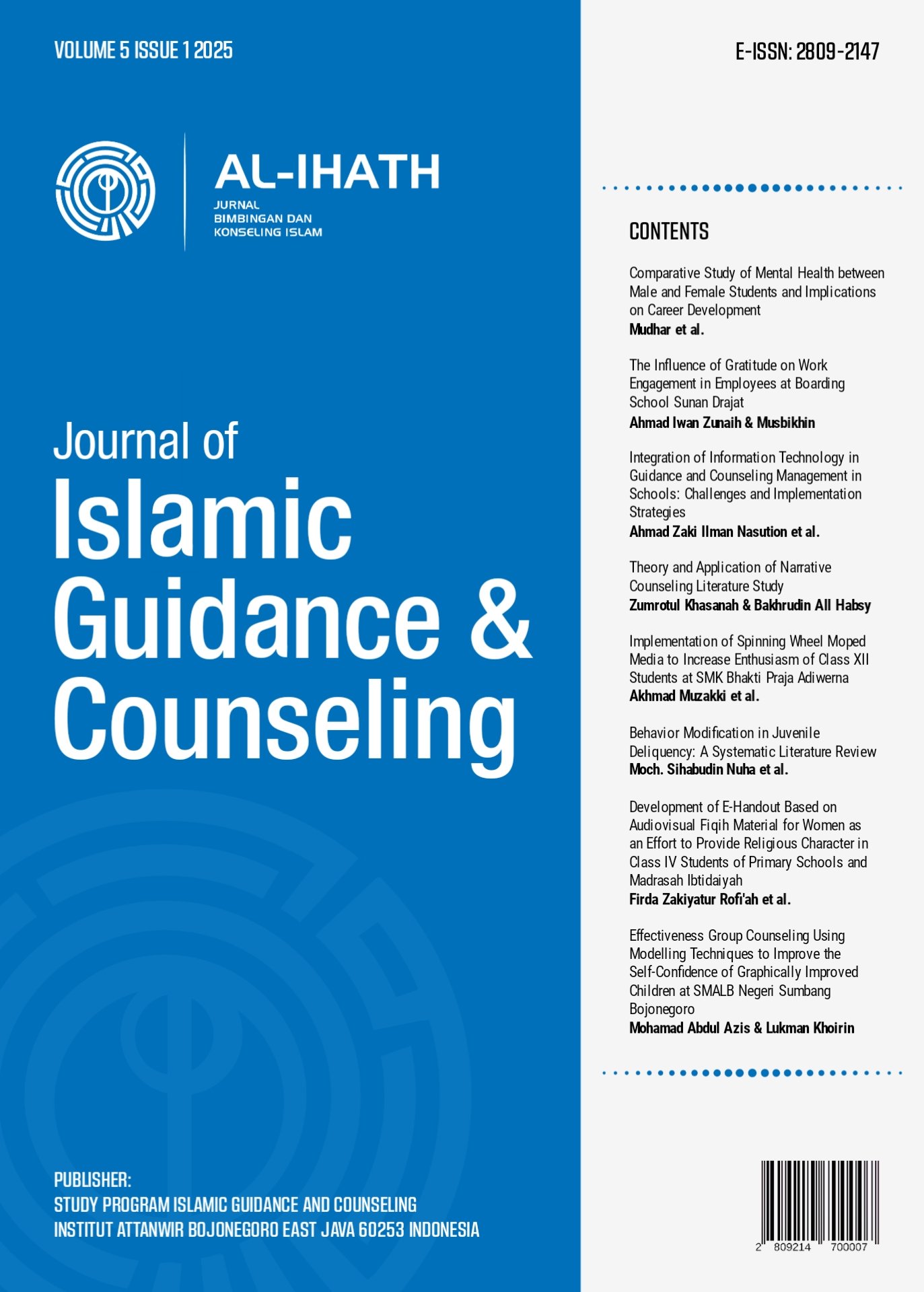Effectiveness Group Counseling Using Modelling Techniques to Improve the Self-Confidence of Graphically Improved Children at SMALB Negeri Sumbang Bojonegoro
DOI:
https://doi.org/10.53915/jbki.v5i1.619Keywords:
Group Counseling, Modelling Techniques, Self-Confidence, Graphically Improved ChildrenAbstract
This research aims to determine the effectiveness of group guidance using modeling techniques to increase the self-confidence of mentally retarded children at SMALB Negeri Sumbang Bojonegoro. This research uses quantitative experimental methods with pre-experimental research designs. The population of this research was 28 Sumbang Bojonegoro State High School students. The sampling technique used in this research was purposive sampling. Researchers used data collectors in the form of the Guttman scale with 2 alternative answer choices, namely Yes and No. The validity test obtained 24 valid item data and 6 invalid items. Meanwhile, from the reliability test, valid item data was obtained from items whose calculated r was ≥ (0.25). Valid items include items 3, 4, 5, 6, 7, 8, 9, 10, 11, 12, 15, 16, 17, 18, 19, 20, 21, 22, 23, 24, 25, 26, 27, 28, 29 with the highest product moment value is item no. 15 with value 0.705 while the lowest value is in item no. 27 with a value of 0.109. Items that were dropped included items 1, 2, 13, 14, 20, and 30 where r calculated ≤ (0.25). Next, a reliability test was carried out using Cronbach's alpha technique with SPSS 22.0 and a reliability value of 0.728 was obtained. Because this data is non-parametric, quantitative analysis without using assumption tests using statistical formulas which in carrying out the analysis use the SPSS 22.0 computer program with the Mann Whitney U Test formula. Apart from that, it is known that the first group's average rank is 3.00, lower than the second rank's average, namely 8.00. This shows that the average pretest score for 5 subjects is lower than the average posttest score. With a U value of 0.000 and a W value of 15,000, if converted to a Z value the value is -2.627. The Sig value is 0.008 < 0.05, which means there is a difference between the two groups, namely the preetest and posttest groups so that Ho is accepted so that there is effectiveness of group guidance to increase the self-confidence of mentally retarded children at SMALB Negeri Sumbang Bojonegoro.
References
Abraham H Maslow. 200. Motivation and Personality”. Jakarta Rajawali
Amin Wahyudi, Mujiyati, Nurbowo Budi Utomo, “Upaya Meningkatkan Kepercayaan Diri Siswa Melalui Konseling Behavioral Dengan Teknik Modeling Pada Siswa Kelas VIII Tunagrahita di SLB Dharna Bhakti, Piyungan Tahun Pelajaran 2020/2021”,
Budianto, A., & Sugiharto, D. Y. P. (2020). EFFECTIVENESS OF GUIDANCE GROUP ROLE PLAYING AND SYMBOLIC MODELLING TO IMPROVE STUDENTS'INTERPERSONAL COMMUNICATION SKILLS. European Journal of Psychological Research Vol, 7(2).
Departemen Pendidikan Nasional. 2011. “Undang-undang SISDIKNAS UU RI NO.20 Th. 2003”. Sinar Grafika, Jakarta.
Depdiknas. 2008. “Peraturan Pemerintah RI No. 19 Tahun 2005 tentang Standar Nasional Pendidikan”. Depdiknas Jakarta.
Ekhsan Muh Rifai. “Pentingnya Kepercayaan Diri Dan Dukungan Keluarga”.
Faizin, M., & Ummah, N. R. (2022). Penerapan Keterampilan Batik Ciprat dalam Melatih Perkembangan Kognitif Anak Tunagrahita. Al-Ihath: Jurnal Bimbingan dan Konseling Islam, 2(1), 32-41.
G. J. Privitera and L. A. Delzell. “Quasy-Experimental and Single- Case Experimental Designs, “in Research Methods for Education, SAGE Pubicaions, Inc., 2019, pp. 333-370
Hakim. 2002. “Mengatasi Rasa Tidak Percaya Diri”. Jakarta: Puspa Swara.
Hafid, A., Zahro, I. F., & Kasih, D. A. (2023). Penerapan Pendekatan Behavioral dengan Teknik Modeling untuk Meningkatkan Kemandirian Anak Tunagrahita SDLB Negeri Sumbang Bojonegoro. Attanwir: Jurnal Keislaman Dan Pendidikan, 14(1), 103-117.
J. R. Fraenkel. N. E. Wallen, and H. H. Hyun. 2022. How to Design and Evaluate Reserch in Education, 8th ed. New York: Mc Graw Hill.
Komalasari Gantina, 2011. “Teori dan Teknik Konseling”. Jakarta: Indesk Press.
Johnsen. 2003. “Pendidikan Kebutuhan Khusus”. Bandung: Unipub Forlag.
Lauster. 1992. Tes kepribadian Terjemahan D.H. Gulo. Jakarta: PT. Gramedia Bumi Aksara
Mumpuniarti. 2000. Penanganan Anak Tunagrahita Kajian Dari Segi Pendidikan, Sosial-Psikologis, Dan Tindak Lanjut Usia Dewasa. Yogyakarta: Jurusan PLB FIP UNY.
Prayitno. Erman Amti. 2013. Dasar-Dasar Bimbingan dan Konseling Jakarta:PT Rineka Cipta.
Repita. “Implementasi Teknik Modeling untuk Meminimalisasi Perilaku Bermasalah Oppositional Defiant Pada Anak Kelompok B. E-Journal Pendidikan Anak Usia Dini Universitas Pendidikan Ganesh”.
Sugiyono. 2014. Metode Penelitian Pendekatan Kuantitatif. Kualitatif. dan R&D. Bandung: Eidos.
Sutarno.1982. “Mengapa Anak Berkelainan Perlu Mendapat Pendidikan”. Jakarta: PN Balai Pustaka, 1982.
Somantri Sutjihati. 2016. Psikologi Anak LuarBiasa. Bandung: RefikaAditama.
Syamsudin, Teknik Modelling dalam Bimbingan Kelompok untuk Meningkatkan Kepercayaan Diri Peserta Didik Kelas VIII G SMP PGRI 6 Bandar Lampung T.P 2017/2018. In Journal
Venni Harivmah, Muhammad Anas. Syamsul Bachri Thalib. 2023. “Penerapan Teknik Modeling Simbolik Dalam Bimbingan Kelompok Untuk Meningkatkan Kepercayaan Diri Siswa Sekolah Menengah Atas di Kabupaten Gowa”, Vol. 3 No. 3.
Zahro, I. F. (2018). Pengaruh bina diri untuk meningkatkan kemandirian anak tunagrahita SDLBN Sumbang III Bojonegoro. Attanwir: Jurnal Keislaman dan Pendidikan, 9(2), 18-28.
Downloads
Published
How to Cite
Issue
Section
License
This work is licensed under a Creative Commons Attribution-NonCommercial 4.0 International License.
Authors who publish with Al-Ihath: Jurnal Bimbingan dan Konseling Islam agree to the following terms:
1) Authors retain copyright and grant Medical Journal of Indonesia right of first publication with the work simultaneously licensed under a Creative Commons Attribution-NonCommercial License that allows others to remix, adapt, build upon the work non-commercially with an acknowledgment of the work’s authorship and initial publication in Al-Ihath: Jurnal Bimbingan dan Konseling Islam.
2) Authors are permitted to copy and redistribute the journal's published version of the work non-commercially (e.g., post it to an institutional repository or publish it in a book), with an acknowledgment of its initial publication in Al-Ihath: Jurnal Bimbingan dan Konseling Islam.



